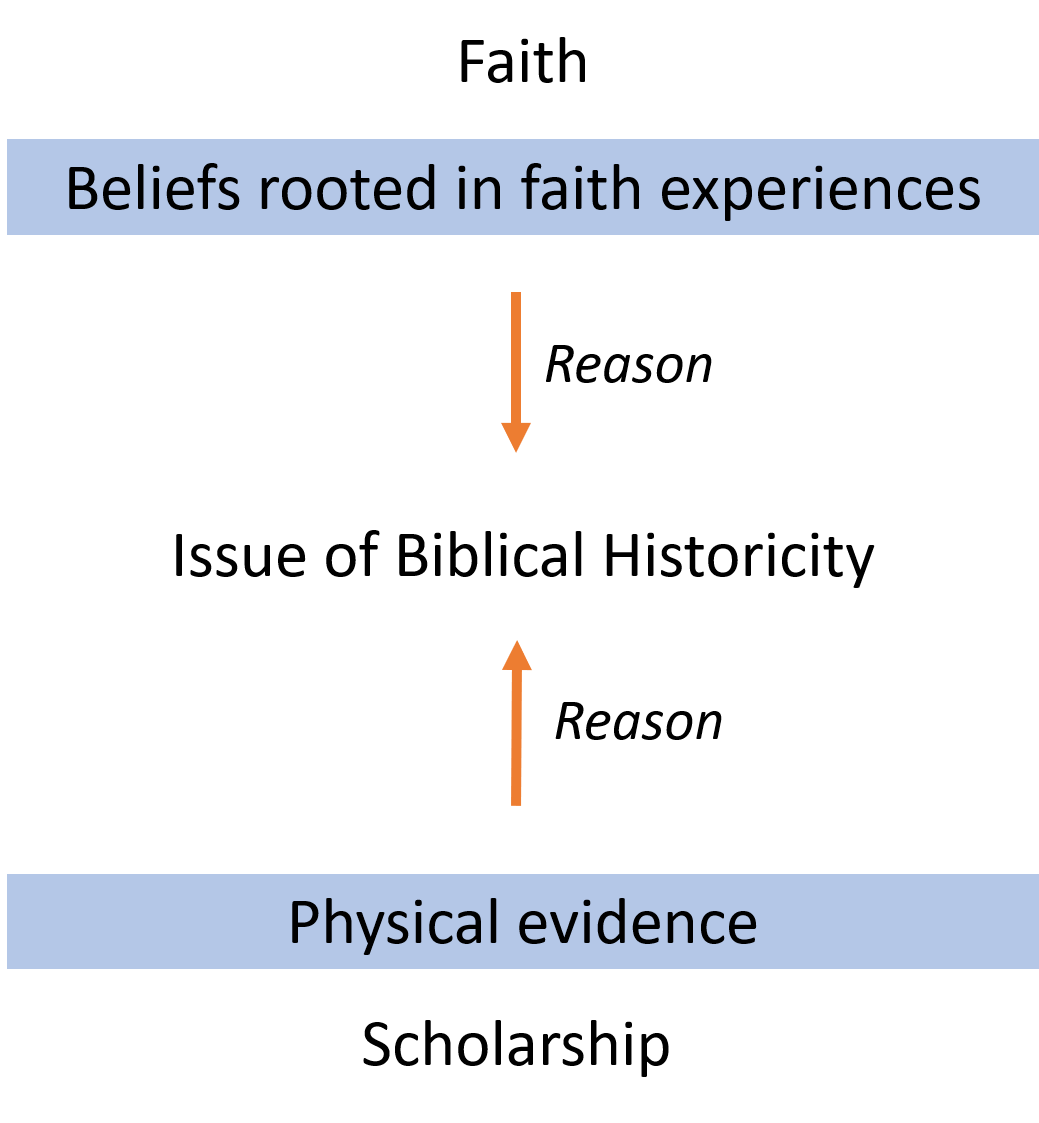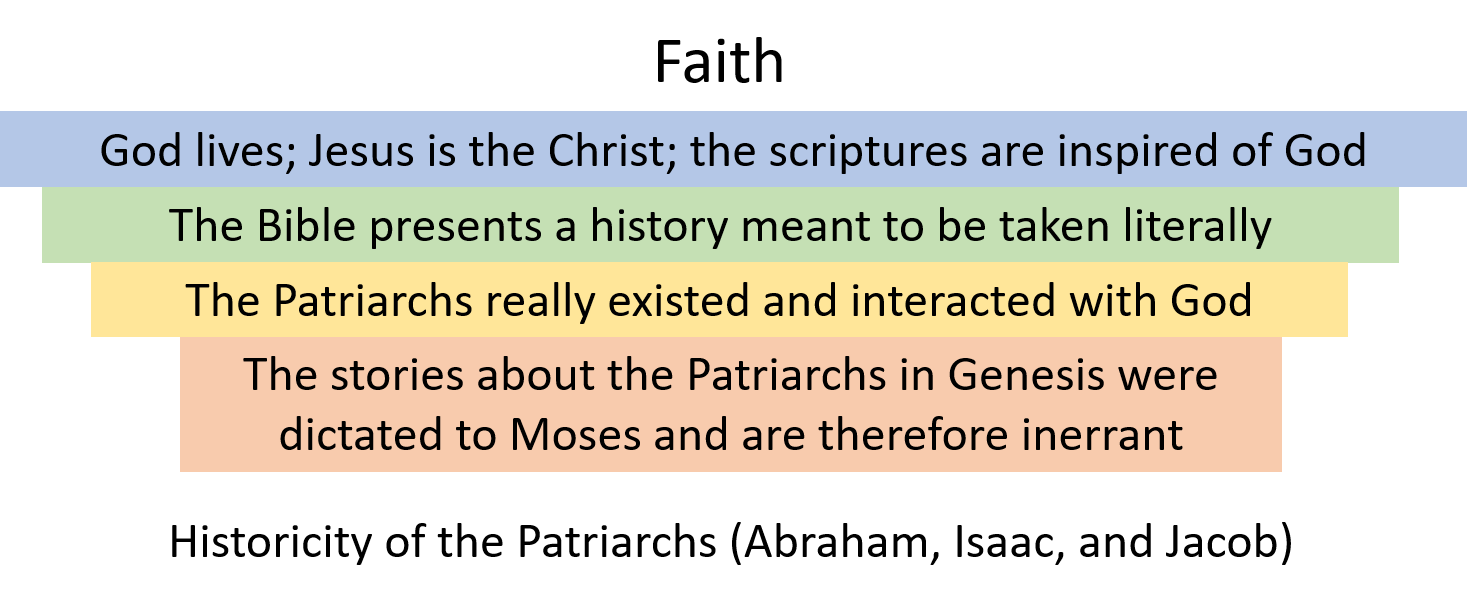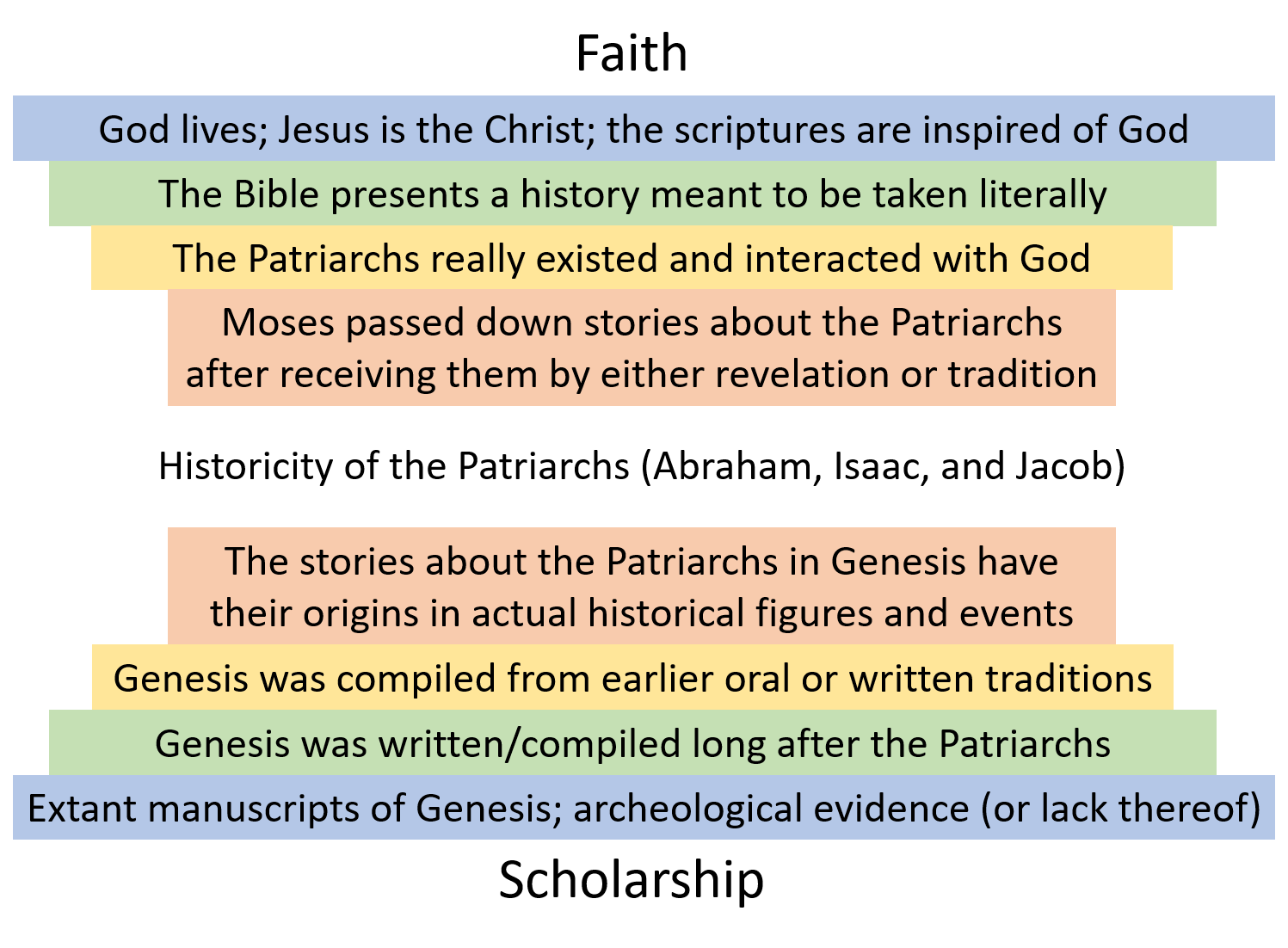
Top Down, Bottom Up
Approaching Issues of Biblical Historicity
By Jeremy Madsen
Jeremy Madsen is a senior studying the ancient Near East at Brigham Young University. This paper is adapted from a presentation he gave at the Creighton Undergraduate Theological Conference in April 2019.
How true is the Bible? This centuries-old debate has been waged in chapels, courtrooms, and colleges around the globe, pitting the claims of secular inquiry against the tenants of religious belief. In these discussions, secular scholarship repeatedly challenges or even derides the historical claims made by biblical texts, and all too often, conservative members of religions react by building walls, either between themselves and scholarship or between themselves and their former faith.
However, these walls are not unavoidable. This paper proposes an eight-step method that members of faith traditions can use to evaluate the claims made by scholarship and by religion, examine each sides’ assumptions and presuppositions, weigh the evidence, and come to a balanced and informed position. While this method will not bring final answers to every issue, it is hoped that this method can help members of religious traditions build bridges, not walls, between them and secular scholarship.
The Battle for Biblical Historicity
The term historicity refers to the actual events behind a historical document. Or, since the “actual” events are wholly inaccessible to modern observers, the term refers to our judgement—based on criteria such as contemporary documents, archeological evidence, and historical probability—of whether the events recorded in a historical document actually occurred as described.1
When dealing with the Bible, the issue of historicity encompasses complex questions, such as, “Did Moses really lead a massive nation out of Egypt, as described in Exodus?” “Was the book of Isaiah really written by a single author in the late eighth century B.C.?” and “Did Jesus really do all that the four Gospels claim he did, including performing miracles and rising from the dead?”
Since the Enlightenment, biblical historicity has been polarized by two different approaches: that of traditional religion, and that of critical scholarship.2 The results have been that critical scholarship, almost without exception, has reached conclusions that conflict with traditional religious beliefs. These conflicts range from minor, like saying that Solomon’s “empire” was much smaller than 1 Kings suggests, to cataclysmic, like saying that Jesus was nothing more than a social reformist who died dejected and disillusioned.3
When believers in the Bible—whether Jew, Catholic, Protestant, or Latter-day Saint—encounter the conclusions of critical scholarship, they often react in one of two ways: either they reject scholarship’s conclusions, along with the scholarly method entirely, or they are plunged into a faith crisis and jettison their convictions and belief system. The first reaction is described by Mary Bader, who teaches an introductory Bible class at the College of Wooster:
A handful of the students, particularly those who are now studying the Bible outside their faith tradition, are encountering marked differences of opinions about the Bible for the first time in their lives. . . . A few do not want to and maybe cannot think critically about the Bible; oftentimes, it is this group that reacts defensively, with hostility, or by shutting down.4
James Robinson, Professor of Religion at Claremont, describes the opposite reaction he faced when he began teaching Biblical studies after a conservative Christian upbringing:
Before going on to graduate studies, I taught for a year . . . a quite literal Old Testament. My students were mostly returning veterans [of critical scholarship], who must have experienced me as hopelessly naïve. Whether or not they actually believed anything I said, by the end of year I no longer did. I had tried to make sense of my childhood theology to myself, and had failed.5
New Testament scholar Craig A. Evans describes this second reaction as “brittle fundamentalism,” the phenomenon that conservative Christians sometimes believe in the inerrancy of scripture so tightly that when undisputable evidence convinces them of a single error, they lose their faith in all of scripture.6
There are problems with both these reactions. If believers reject their faith, they are rejecting the truths they have built their lives around, truths that may have been confirmed to them by sacred spiritual experiences. On the other hand, if believers reject the scholarly method, they lose the chance to benefit from the wealth of insights about the Bible that scholarship offers.
Is there a way to reconcile conflicts between faith and scholarship? I believe there is. In this paper, I will lay out a method whereby believers can synthesize arguments from both scholarly criticism and faith, drawing on each approach’s respective insights while avoiding their respective pitfalls. My purpose is not to make an argument about a specific issue of historicity, but to propose a method that any believer, from any background, can adjust to his or her own scenario.7
The Method

The method that I propose asserts that any issue of biblical historicity can be approached simultaneously from two different angles:
- from the bottom upward, using reason to draw conclusions from physical evidence (the scholarly approach), and
- from the top downward, using reason to draw conclusions from beliefs rooted in faith experiences (the faith approach).
The exact source of these beliefs will vary; for some believers it might be personal spiritual experiences; for others, faith in the creeds and doctrines of their church; for others, trust in the teachings of their parents.
This method asserts that both approaches—scholarship and faith—are valid ways of discovering truth. Often, beliefs grounded in faith are dismissed as “superstitious,” “unreasonable,” or “unfounded.” But this method asserts the validity of faith and personal spiritual witness as a source of truth. These two approaches work best in concert: just as in a chemistry lab multiple instruments are used to verify the result of an experiment, so these two approaches can cover for each other’s blind spots, helping a believer come to a fuller knowledge of the truth. Note that this method is not “faith vs. reason.” Both approaches use reason to evaluate evidence; the difference is where the evidence comes from.8
The method proposed in this paper follows eight steps:
First, the believer identifies an issue in question: likely an issue that has recently surfaced in the believer’s studies and that challenges the believer’s existing ideological worldview. Major issues related to the Bible are not hard to come by, and include all of the following hot topics: Is there a God? Was the earth created in six days? Was man spontaneously created? Was there a global flood? Did all humankind once speak the same language? Did the patriarchs exist? Did Moses? Did the Exodus happen? Did the Israelites cross the Red Sea? How did the Israelites emerge as a people in Israel? How accurate are the historical accounts in the Bible? Did Moses author the Pentateuch? Did Isaiah write the entire book of Isaiah? Is Jesus’s infancy narrative true? Did Jesus perform the miracles depicted in the Gospels? Who wrote the Gospel accounts, and how accurate are they? Did Paul write all the letters attributed to him? Did John write Revelation? Did Jesus really rise from the dead? Whatever issue the believer chooses, he or she then creates a graph and writes that issue at the center.
Second, the believer gathers claims about the issue, from both scholarship and faith. Obviously, consulting trustworthy sources is essential, for both sides. Each one of the issues mentioned above is incredibly complex, with fountains of words published on both sides of a heated debate. The believer should shy away from more sensational sources of information—documentaries, blogs, tabloid articles, YouTube videos—and seek more credible, well-thought out positions, like books (not self-published ones), articles published in respectable scholarly or religious venues, and the biblical text itself. The believer may want to seek out trusted experts, such as a trained pastor or a biblical scholar, and talk to them in person. Most importantly, the believer should spend time researching both sides of the argument; a one-sided research session will yield one-sided results. The believer should keep careful track of every claim he or she finds.
Third, the believer places these claims on the graph; claims from scholarship are placed working upwards towards the issue from the bottom of the graph, while claims from faith are placed working downwards towards the issue from the top of the graph. While placing the claims, the believer ranks them on a spectrum of certainty that comprises four categories: sure, sound, probable, and possible.
For scholarship, these categories are manifested as (1) physical evidence (extant manuscripts of the Bible and archeological data), (2) sound deductions (basic conclusions agreed upon by the entire scholarly community), (3) probable theories (current theories given credence by many scholars but still under some dispute), and (4) possible conjectures (unproven claims made by individual scholars that are frequently challenged in scholarly circles).
For faith, these categories are manifested as (1) core tenants of faith (central truths that form the foundation of the believer’s testimony), (2) sound doctrines (doctrines that are generally agreed upon by the believer’s religious community), (3) probable beliefs (reasonable conclusions that stem from the tenants and doctrines but that maybe are not clearly defined or agreed upon by a religious community), and (4) possible conjectures (ideas or assumptions about exact particulars that may differ from believer to believer). As the claims work towards the middle, the level of certainty decreases.
Fourth, the believer evaluates. Do claims from scholarship and claims from faith conflict? When they do, allow more-certain claims to refute less-certian claims. For example, a sound doctrine will refute a possible scholarly conjecture, while reversely, a sound scholarly deduction will refute a possible faith-based conjecture.
Fifth, the believer explores other options. What have other scholars proposed? What other conclusions could be reached from faith? This may involve reading additional material, examining assumptions, and thinking deeply. The believer should continue considering alternatives until he or she has reached a satisfactory model free of conflict.
Sixth, the believer should admit uncertainty and await further insights. Because information from both approaches is limited, we must avoid dogmatic inflexibility from either side. We must be willing to adapt our model as further information comes to light.
Seventh, the believer should seek to benefit from the scholarship. Scholarship is meant to lead us to truth by helping us better understand the text and the culture and history behind it. By identifying what scholarly claims we can trust, we can then use their insights to enrich our study of the scriptures.
Eighth, last of all, the believer should live the faith. The layout of this model emphasizes that scholarly arguments can never disprove core tenants of faith. Core tenants of faith are a starting point, not a conclusion. Their veracity is independent of anything else. Thus in this method, a believer’s core testimony should never be under threat, even if claims based on that testimony are refuted by scholarly evidence.

Illustration of the Method
As an illustration, we’ll explore how a hypothetical believer—we’ll call him Jim—might apply this method. (The following is meant as only a possible illustration, so some readers may disagree with the details of Jim’s decisions. The purpose is to illustrate the method at work, not make an argument for or against the illustrated issue.)
First, Jim identifies an issue in question. Jim recently read a magazine article claiming that the patriarchs—Abraham, Isaac, and Jacob—never existed, and that the stories about them in Genesis are fictitious. He finds the article disturbing and unsettling, and he decides to examine the issue further.
Second, Jim gathers claims made about the issue. He tracks down some scholarly publications referenced in the article he read. He talks with some friends in his congregation that he knows are well-educated and informed but also firm in their faith. He also goes to his local library and checks out a textbook on the history of ancient Israel. He studies the stories in Genesis and ponders what they mean to him on a spiritual level. With each new discovery, his fascination with the topic grows.
Third, Jim writes the claims he has found on a graph, ranking them on a spectrum of certainty. He begins with his traditional religious beliefs. Jim is a Christian, and as a Christian, he accepts the Hebrew Bible as his Old Testament. For core tenants of faith, he puts his sure witness that God exists, that Jesus is the Christ, and that the Bible is inspired of God. The next question for Jim is whether the Bible is a presentation of literal history or a largely fictional work that teaches about God symbolically. He decides that a sound doctrine for his faith is that the Bible presents a story meant to be taken as literal. Since the Bible describes the lives of the patriarchs in detail, the probable belief based on this sound doctrine is that Abraham, Isaac, and Jacob really existed and interacted with God in important ways. Jim has long assumed that the stories about the Patriarchs in Genesis were dictated to Moses and are therefore infallible. But in the course of his research, he realizes he doesn’t have much scriptural basis for this claim, so he labels it as a possible conjecture.

Next, Jim adds to the graph the claims he found made by scholarship, ranked on the spectrum of certainty. For sure evidence, Jim puts extant manuscripts of Genesis and relevant archeological evidence (although he has found that for the Patriarchs there is practically none). For sound deductions, Jim has found a clear consensus in the scholarly community that Genesis was written (or at least compiled into its final form) between the eighth and fifth centuries B.C., long after the time of the Patriarchs and even well after Moses. For probable theories, Jim finds a statement by renowned archeologist Hershel Shanks that “the written stories of the patriarchs . . . reflect primarily the Iron Age [first millennium] context in which they were first compiled and edited,” rather than the Late Bronze Age (second millennium) when the patriarchs were supposed to have lived.9 Jim finds that most scholarship agrees with Shanks, although there are a few dissenters. For possible conjectures, Jim finds the ideas of biblical scholar and historian John Van Seters, who argues that the patriarchal traditions were created in the Iron Age and that the patriarchs are nothing more than mythical founding figures imagined up by later Israelites.10
Fourth, Jim evaluates the claims on his graph. Clearly, there are conflicts! The scholarly conjecture that the patriarchs never existed clashes with Jim’s probable belief that they did. He allows the stronger claim to refute the weaker one. The scholarly arguments depend on the lack of archeological evidence, but Jim recognizes that a lack of evidence in favor is not evidence against. Jim also recognizes, however, that his conjecture that the stories about Genesis are infallible Mosaic texts is unreasonable. Scholarship has clearly demonstrated that the text of Genesis, even if it had its beginnings around Moses’s time, underwent many later changes, redactions, and developments.
Fifth, Jim explores other options. He finds a branch of scholarship that demonstrates that while Genesis does reflect conditions of the first millennium, it was likely compiled from earlier oral or written traditions. He even finds some scholars who claim that these traditions go back for centuries, and that they likely had their origins in real historical figures and events.11 Jim also examines his faith-based assumptions and decides that a more reasonable conjecture—still without much textual confirmation—is that the stories about the patriarchs came to Moses by either tradition or by revelation from God, and that Moses passed these stories down to later generations of Israelites who changed or adapted them. Jim has now achieved a model that works for him. No glaring conflict remains, and together the two approaches have given him a picture much more complete than a single approach could have by itself.
Sixth, Jim admits a degree of uncertainty. The conjectures on his graph are still conjectures, even though they no longer conflict. Future archeological evidence may support the existence of the Patriarchs or clarify when the stories were written. Or God may even reveal more about the matter. Only time will tell.
Seventh: For now, Jim can benefit from the scholarship. Jim has long been puzzled by some of the stories in Genesis, including some seeming contradictions and duplications. By accepting that these stories aren’t perfect, he can learn from some of the literature seeking to explain how they may have been adapted over time.
Eighth: Most importantly, Jim can continue to live his faith. The magazine article he read no longer troubles him; he can read the scriptures, worship at church, and ponder the significance of the patriarchal stories in his life without the nagging doubt that everything he believes is a lie.


The above illustration is how Jim, a hypothetical person, has handled this issue. In real life, others may approach the same issue differently and find vastly different results. The purpose of this method, however, is not to establish a consensus in the community at large about every difficult issue. The purpose of this method is to help individuals stuck between faith and scholarship to handle and resolve conflicting claims.
Conclusion
The world is full of competing claims. Academic scholarship and religious faith have different starting points, evidence, methods, and goals. With such divergent paths, gaping disparities in their conclusions are inevitable. However, with the method outlined above, those who believe in faith traditions but still honor the scientific method can build bridges, not walls, between these two traditions.
Academic scholars—even those who do not believe that the Bible is inspired—can also benefit from this method. Much of biblical scholarship circulates only within its own insular community, and many scholars are dissatisfied with how most readers of the Bible are unfamiliar with scholarly research.12 But is it any wonder that many believers shy away from biblical scholarship, when that scholarship is so frequently caustic to their beliefs? Using this method as a guide, scholars writing to a religious audience can couch their claims in a framework that encourages, rather than ridicules, religious beliefs.
In my personal studies in the Ancient Near Eastern program at BYU, this model has helped me immeasurably. Frequently, after class periods filled with discussions of historical evidence and critical methodology, I find myself full of questions and swimming in doubts. But then I walk myself through this model, either in writing or in my head, and soon everything becomes clearer. The exercise reminds me that not all scholarly claims, and not all faith-based beliefs, are created equal. Some scholarly claims have little evidence behind them; others have a great deal. Some beliefs are, in the words of one of my academic mentors, “unnegotiable.” Others perhaps can be negotiated.
When using this method, I have found that prayer is crucial. Prayer enlightens my mind, increases my ability to reason, and connects me with God. Prayer invites the Holy Ghost, and I believe that “by the power of the Holy Ghost, [we] may know the truth of all things,” including issues of Biblical historicity.
In the Latter-day Saint community, debates between faith and scholarship extend well beyond the Bible. Similar conflicts erupt about the historicity of the Book of Mormon, the origins of the books of Moses and Abraham, issues in Church history, and matters of Church policy and doctrine. Encountering challenging ideas is not a matter of if, but a matter of when, and many respond by either building a wall around their faith—thereby making it blind—or walling off their faith, making it dead.
With some adaptation, this method can be applied to any issue where faith and secular ideas clash. Do careful research and gather claims—from both sides. Examine arguments’ presuppositions and assess levels of certainty. Decide what your core doctrines are, and don’t surrender them in battles over peripheral conjectures. Learn to live with uncertainty, but keep the faith anyway.
Neal A. Maxwell, an eminent Latter-day Saint scholar and apostle, taught the value in allowing faith and scholarship to coexist: “The real test is individual discipleship, not scholarship. But how good it is when these two can company together, blending meekness with brightness and articulateness with righteousness.”13 As we seek to synthesize competing claims, we can overcome divisions, achieve this beautiful blend, and build lasting connections between scholarship and faith.
1. For a discussion of our ability to determine “historical truth,” see, for example, Jonathan A. C. Brown, “Did the Prophet Say It or Not? The Literal, Historical, and Effective Truth of Hadiths in Early Sunnism,” Journal of the American Oriental Society 129.2 (2009): 264-265; and J. Maxwell Miller, The Old Testament and the Historian (Minneapolis: Fortress Press, 1976), 11–19.
2. Note that the scholarly approach is called “critical” not because it seeks to criticize the text, but rather because it seeks to examine the text critically, or closely and rationally.
3. For a survey of the variety of interpretations of the historical Jesus, along with the conservative reaction to them, see Craig A. Evans, Fabricating Jesus: How Modern Scholars Distort the Gospels (Downers Grove, IL: InterVarsity Press, 2008).
4. Mary Bader, "Strategies for Moving Students from Faith-based to Academic Biblical Studies," SBL Forum, accessed October 31, 2019, at http://sbl-site.org/Article.aspx?ArticleID=467.
5. James Robinson, as quoted in Evans, Fabricating Jesus, p. 23.
6. Evans, Fabricating Jesus, p. 31.
7. This method is meant to be used on a personal basis by individual believers, not as a methodology in scholarly circles, nor as a tool to shape a church’s doctrines.
8. Western culture has developed a strong dichotomy between faith and reason, a dichotomy that seems to go back to second- and third-century conflicts in the Christian church between Greek philosophy and Jewish theology. Addressing the history and nature of this dichotomy (which I believe to be a false one) is outside the scope of this paper, however.
9. Hershel Shanks, “Who Wrote Down the Stories of the Patriarchs and When?” p. 5 in Ancient Israel: From Abraham to the Roman Destruction of the Temple (3rd edition), edited by Hershel Shanks (New Jersey: Prentice Hall; Washington D.C.: Biblical Archaeology Society, 2011).
10. John Van Seters, Abraham in History and Tradition (New Haven: Yale University Press, 1975).
11. See, for example, P. Kyle McCarter Jr., “The Patriarchal Age: Abraham, Isaac, and Jacob,” p. 1–34 in Ancient Israel: From Abraham to the Roman Destruction of the Temple (3rd edition), edited by Hershel Shanks (New Jersey: Prentice Hall; Washington D.C.: Biblical Archaeology Society, 2011).
12. See, for example, “About Us,” Bible Odyssey, the Society of Biblical Literature, accessed November 16, 2019, bibleodyssey.org.
13. Neal A. Maxwell, “Discipleship and Scholarship,” BYU Studies, 32.3.
What are your thoughts about this method? What is a time you’ve grappled with uncertainty? Please share your thoughts.
(Comments are moderated.)
